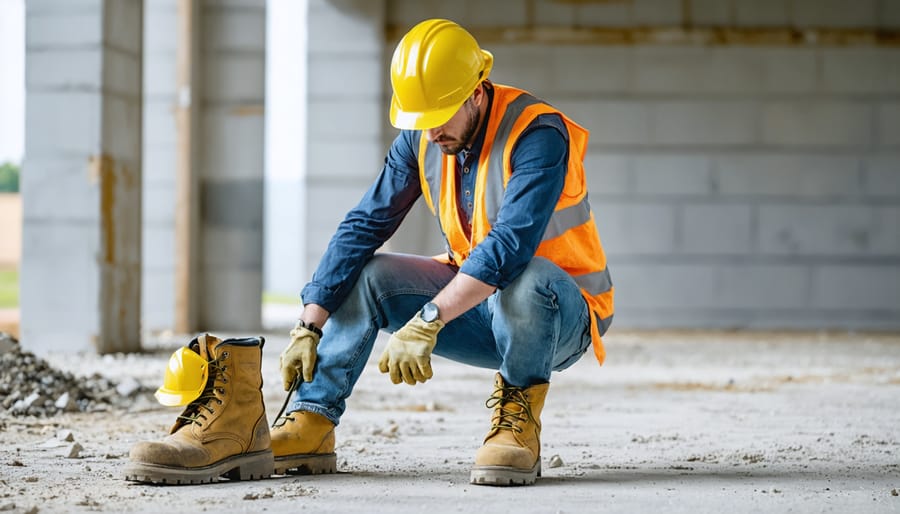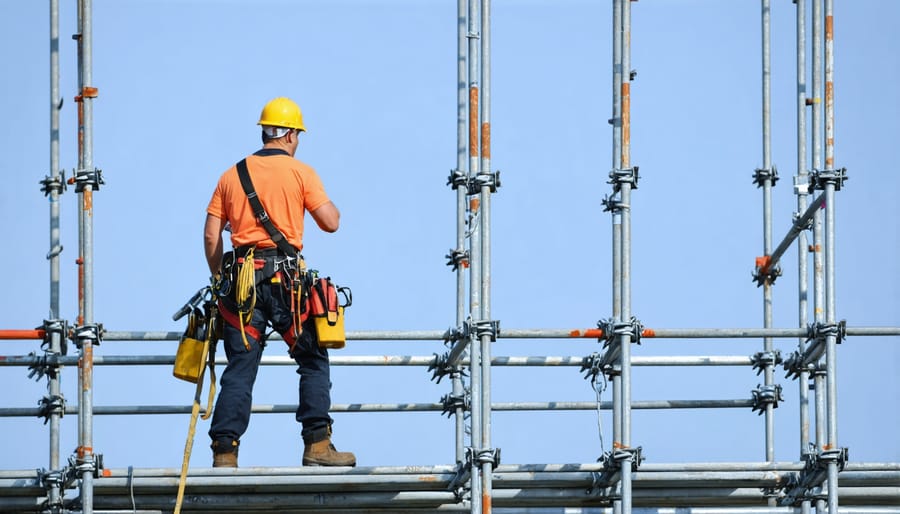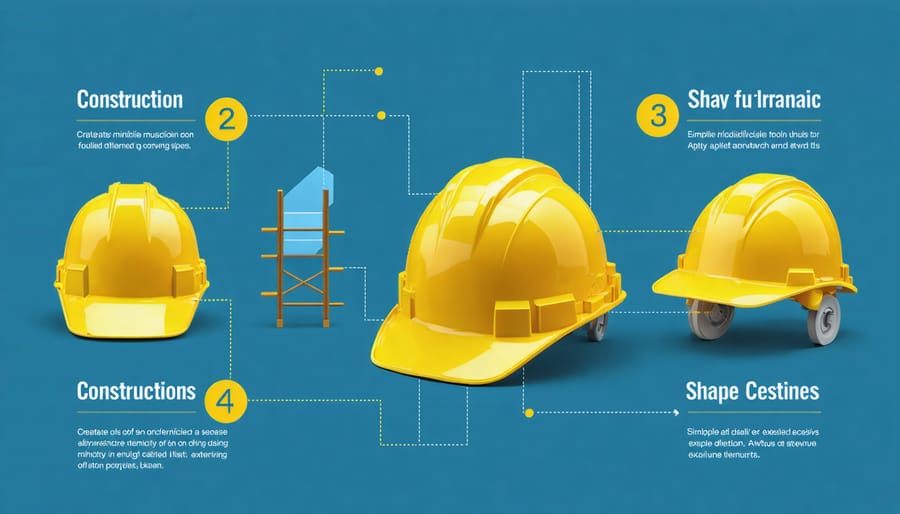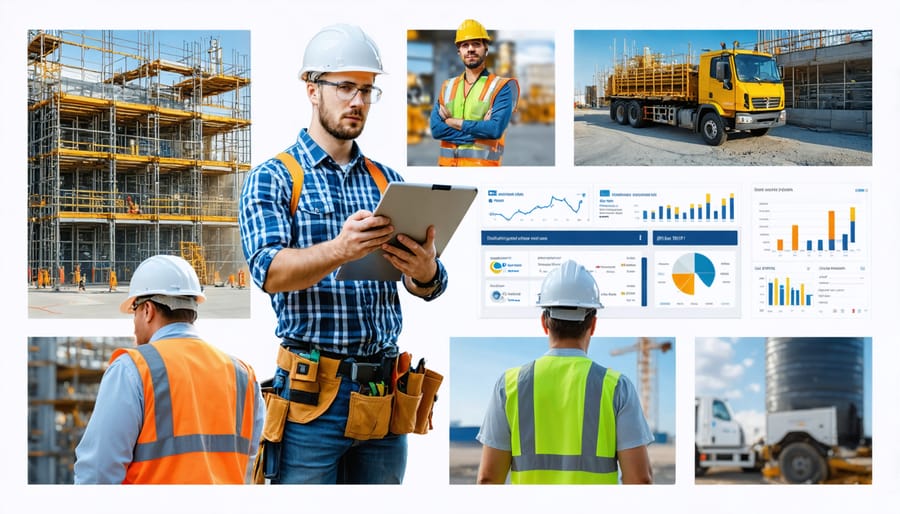Construction safety compliance saves lives and protects businesses, making OSHA construction regulations the cornerstone of modern jobsite management. Each year, preventable accidents cost the construction industry billions in losses, medical expenses, and productivity disruptions. Yet implementing comprehensive safety standards reduces workplace incidents by up to 85% while delivering measurable returns on investment through decreased insurance premiums and improved operational efficiency.
Recent data from the Bureau of Labor Statistics reveals that construction firms with robust OSHA compliance programs experience 48% fewer safety incidents and maintain workforce retention rates 37% higher than industry averages. For construction executives and project managers, mastering these standards isn’t just about avoiding citations—it’s a strategic imperative that drives operational excellence, enhances competitive advantage, and demonstrates commitment to workforce protection.
This practical guide examines critical OSHA requirements, implementation strategies, and compliance best practices, equipping construction professionals with the knowledge needed to create safer, more productive jobsites. From fall protection protocols to hazard communication systems, we’ll explore evidence-based approaches that leading firms use to exceed safety benchmarks while maintaining project timelines and budgetary constraints.
Core OSHA Construction Safety Requirements
Fall Protection Standards
Fall protection remains one of OSHA’s most critical safety requirements in construction, with the standard applying to work performed at heights of 6 feet or more above lower levels. Employers must provide fall protection systems that include guardrail systems, safety net systems, or personal fall arrest systems (PFAS).
For residential construction, contractors must implement fall protection measures when workers are exposed to falls of 6 feet or more from unprotected sides and edges. Guardrail systems must be at least 42 inches high, capable of withstanding 200 pounds of force, and include midrails or equivalent protection between the top rail and walking surface.
Personal fall arrest systems require anchorage points capable of supporting 5,000 pounds per attached worker. These systems must be inspected prior to each use and immediately removed from service if any defects are found. Safety nets, when used, must be installed as close as possible under the walking/working surface but never more than 30 feet below.
OSHA mandates specific fall protection requirements for different construction activities:
– Leading edge work requires guardrail systems, safety net systems, or personal fall arrest systems
– Roof work demands protection based on roof slope and height
– Excavation edges necessitate guardrails or barricades when not readily visible
– Dangerous equipment areas require fall protection regardless of height
Employers must also provide training to workers about fall hazards and the proper use of fall protection systems. This training must be documented and conducted by a qualified person who can identify and evaluate fall hazards.
Personal Protective Equipment (PPE)
Personal Protective Equipment represents a critical line of defense in construction safety, and OSHA mandates specific PPE requirements under 29 CFR 1926 Subpart E. Employers must provide appropriate PPE and ensure workers use it correctly in hazardous conditions.
Head protection (hard hats) must meet ANSI Z89.1 standards and is mandatory in areas with potential falling object hazards or electrical dangers. Eye and face protection, including safety glasses, goggles, or face shields, is required when workers are exposed to flying particles, chemicals, or harmful light radiation.
Respiratory protection becomes necessary when engineering controls cannot adequately control exposure to harmful dusts, fogs, fumes, or vapors. Workers must use appropriate hearing protection when noise levels exceed 85 decibels averaged over an eight-hour workday.
Hand protection requirements vary based on specific hazards, from cut-resistant gloves for handling sharp materials to chemical-resistant gloves for handling hazardous substances. Safety-toed footwear complying with ASTM F-2413-05 standards is essential when working with heavy materials or equipment.
Fall protection equipment, including personal fall arrest systems, must be provided when working at heights of six feet or more above lower levels. Employers must train workers on proper PPE use, maintenance, and limitations, documenting all training sessions and equipment inspections for compliance verification.

Site-Specific Safety Protocols

Scaffolding and Elevated Work
OSHA’s scaffolding standards (29 CFR 1926.451) establish comprehensive requirements for scaffold safety in construction. These standards mandate that scaffolds must support at least four times their maximum intended load and be erected on solid footing. Each scaffold platform must be fully planked or decked, with spaces no greater than 1 inch between adjacent units or the uprights.
Qualified personnel must supervise scaffold assembly, dismantling, and modification. Daily inspections are required before each work shift and after any occurrence that could affect structural integrity. Workers must maintain proper fall protection, including guardrails for scaffolds 10 feet or higher and personal fall arrest systems when applicable.
Access requirements specify that proper ladders, stair towers, or ramps must be provided when platforms are more than 2 feet above or below a point of access. The standards also address clearance from power lines, with a minimum distance of 10 feet for most electrical hazards.
For suspended scaffolds, all support devices must be capable of supporting six times the intended load. Wire ropes and hardware must be inspected before each workshift, and damaged components must be immediately removed from service.
Training requirements mandate that workers receive instruction on scaffold hazards, fall protection, electrical hazards, and proper material handling. Retraining is necessary when workplace conditions change or when workers demonstrate a lack of skill or understanding.
Excavation and Trenching
OSHA’s excavation and trenching standards are critical safety requirements that protect workers from cave-ins and other hazards. These regulations mandate that all excavations deeper than 5 feet must have adequate protective systems unless the excavation consists entirely of stable rock.
Soil classification is a fundamental requirement, with soils categorized into four types: Stable Rock, Type A, Type B, and Type C. Each classification demands specific protective measures based on cohesion, internal angle of friction, and unconfined compressive strength. Competent persons must classify soil conditions daily and after any changing conditions like rainfall.
Protective systems must be implemented according to soil type and depth. These include sloping, benching, shoring, and shielding systems. For excavations deeper than 20 feet, protective systems must be designed by a registered professional engineer. Shoring systems require regular inspection and maintenance to ensure continued effectiveness.
Safe access and egress are mandatory for trenches 4 feet or deeper, with ladders, steps, or ramps positioned within 25 feet of workers. These access points must extend at least 3 feet above the trench edge. Surface encumbrances must be removed or supported, and spoil piles must be placed at least 2 feet from trench edges.
Daily inspections by competent persons are required before work begins and throughout the shift, particularly after rainstorms or other hazard-increasing events. These inspections must assess protective systems, potential cave-in hazards, and atmospheric conditions when necessary.

Electrical Safety
OSHA’s electrical safety standards for construction sites (29 CFR 1926 Subpart K) establish comprehensive requirements to protect workers from electrical hazards. These standards mandate that all electrical equipment must be approved by recognized testing laboratories and installed according to the National Electrical Code requirements.
Workers must maintain safe distances from energized power lines, with a minimum clearance of 10 feet for lines rated 50kV or less. For every additional 10kV, an extra 0.4 inches of clearance is required. All temporary wiring must be protected by ground-fault circuit interrupters (GFCIs), and extension cords must be three-wire type with proper grounding.
Personal protective equipment (PPE) requirements include insulated gloves, flame-resistant clothing, and appropriate footwear when working with electrical systems. Only qualified personnel may work on energized circuits, and proper lockout/tagout procedures must be followed during maintenance or repair operations.
Regular inspections of electrical equipment are mandatory, with documentation of findings and immediate correction of identified hazards. Temporary lighting must be equipped with guards to prevent accidental contact with bulbs, and all electrical installations in wet locations require weatherproof enclosures.
These standards also require proper identification and marking of circuit breakers, maintaining clear access to electrical panels, and implementing an effective electrical safety program that includes worker training and emergency response procedures.
Compliance and Documentation
Record Keeping Requirements
OSHA mandates comprehensive record-keeping practices to ensure construction companies maintain accurate documentation of workplace safety incidents and compliance measures. These safety compliance requirements include maintaining OSHA 300, 300A, and 301 forms, which document work-related injuries and illnesses.
Employers must record all workplace injuries and illnesses within seven calendar days of receiving information about the incident. These records must be maintained for a minimum of five years following the end of the calendar year they cover. Additionally, Form 300A, which summarizes the year’s occupational injuries and illnesses, must be posted in a visible workplace location from February 1 to April 30 each year.
Construction companies must also maintain documentation of employee training, equipment inspections, and hazard assessments. This includes records of toolbox talks, safety meetings, and specialized training certifications. Emergency action plans, fall protection programs, and hazard communication programs must be documented and readily available for OSHA inspection.
Digital record-keeping systems are becoming increasingly common, but employers must ensure these systems meet OSHA’s accessibility and retention requirements. Regular audits of record-keeping practices help ensure compliance and identify areas for improvement in safety documentation procedures.
Training and Certification
OSHA mandates specific training requirements for construction workers to ensure workplace safety and regulatory compliance. Workers must receive comprehensive training in hazard recognition, proper equipment operation, and emergency procedures relevant to their job duties. This training must be conducted in a language workers can understand and documented for OSHA verification.
Key certification requirements include the OSHA 10-hour Construction Safety Course for entry-level workers and the OSHA 30-hour Construction Safety Course for supervisors and safety managers. These courses cover essential topics such as fall protection, electrical safety, scaffolding, and personal protective equipment (PPE).
Specialized certifications are required for specific construction activities. Crane operators must obtain certification from accredited organizations like NCCCO or NCCER. Workers involved in confined space operations need confined space entry training, while those handling hazardous materials must complete HAZWOPER certification.
Employers must maintain accurate training records, including dates, topics covered, and instructor qualifications. Regular refresher training is essential, particularly when new equipment is introduced or workplace conditions change. Site-specific training addressing unique hazards and emergency procedures must supplement general safety training.
Construction companies should implement a systematic approach to training, incorporating hands-on demonstrations, competency assessments, and periodic evaluations to ensure knowledge retention and practical application of safety protocols.
Implementation Strategies

Safety Program Development
Developing a comprehensive construction safety program requires a systematic approach aligned with OSHA standards and proven EHS compliance strategies. Begin by conducting a thorough workplace hazard assessment to identify potential risks specific to your construction operations. This assessment should cover equipment usage, work processes, and environmental factors.
Create written safety policies and procedures that address identified hazards and clearly outline responsibilities at all organizational levels. Establish a safety committee comprising management and workers to oversee program implementation and maintain regular communication channels.
Implement a robust training program that includes both initial and ongoing education for all employees. Training should cover general safety principles, job-specific hazards, emergency procedures, and proper use of personal protective equipment (PPE). Document all training sessions and maintain detailed records of attendance and certifications.
Regular program evaluation is essential for effectiveness. Conduct periodic safety audits, analyze incident reports, and track leading indicators such as near-misses and safety observations. Use this data to identify trends and areas for improvement.
Ensure management commitment through visible leadership, allocation of necessary resources, and active participation in safety initiatives. Foster a culture of safety by recognizing and rewarding safe behaviors while addressing unsafe practices promptly and consistently.
Update your safety program regularly to incorporate new OSHA requirements, industry best practices, and lessons learned from incidents or near-misses. This continuous improvement approach helps maintain program relevance and effectiveness.
Common Compliance Challenges
Construction companies frequently encounter several significant compliance challenges when implementing OSHA safety standards. Fall protection remains the most cited violation, with many firms struggling to maintain consistent safety harness usage and proper guardrail installation. The dynamic nature of construction sites makes it particularly challenging to ensure continuous fall protection systems across all work areas.
Documentation and recordkeeping present another major hurdle, as companies must maintain detailed injury logs, inspection records, and training certifications. Many firms find it difficult to keep these records current and readily accessible during OSHA inspections. The solution often lies in implementing digital documentation systems and establishing clear recordkeeping protocols.
Employee training and communication barriers also pose significant challenges, especially on multilingual worksites. Successful companies address this by providing training materials in multiple languages and using visual aids to convey safety requirements effectively.
Equipment maintenance and inspection compliance frequently create difficulties, particularly regarding scaffold safety and heavy machinery operations. Regular inspection schedules, detailed maintenance logs, and employee accountability programs help address these concerns.
Cost considerations often impact compliance efforts, with smaller contractors struggling to balance safety investments with operational expenses. However, successful organizations view safety compliance as a long-term investment that reduces accident-related costs and improves productivity. Implementing a systematic approach to safety management, including regular audits and continuous improvement processes, helps companies overcome these common challenges while maintaining OSHA compliance.
Recent Updates and Future Trends
Recent OSHA construction safety standards have undergone significant updates, reflecting evolving industry challenges and technological advancements. In 2023, OSHA introduced enhanced requirements for fall protection in residential construction, particularly focusing on leading edge work and roof activities. The agency also strengthened crystalline silica exposure monitoring requirements, implementing more stringent documentation processes.
A notable development is the integration of digital compliance tools into safety management systems, streamlining documentation and real-time monitoring of workplace conditions. These technological solutions are becoming increasingly central to OSHA’s enforcement and compliance strategies.
Looking ahead to 2024-2025, OSHA is expected to release updated guidelines for crane operation safety, incorporating lessons learned from recent incidents and technological improvements. The agency is also developing new standards for heat exposure protection, responding to increasing concerns about climate-related workplace hazards.
Industry experts anticipate upcoming revisions to trenching and excavation requirements, with an emphasis on real-time soil stability monitoring and enhanced emergency response protocols. Additionally, OSHA is reviewing standards for powered industrial trucks and exploring new regulations for autonomous construction equipment.
These developments reflect OSHA’s commitment to adapting regulations to meet emerging challenges while leveraging technological innovations for improved safety outcomes. Construction companies should prepare for increased emphasis on data-driven safety management and enhanced documentation requirements across all operational aspects.
OSHA construction safety standards serve as the cornerstone of workplace safety in the construction industry, and their importance cannot be overstated. Throughout this comprehensive overview, we’ve explored the fundamental requirements, implementation strategies, and critical compliance measures that construction professionals must understand and follow.
The key takeaway is that OSHA standards are not merely regulatory hurdles but essential guidelines that protect workers’ lives and ensure project success. From fall protection and scaffolding requirements to electrical safety and hazard communication, each standard addresses specific risks inherent to construction operations. Successful implementation requires a commitment to ongoing training, regular site inspections, and systematic documentation.
Construction companies must recognize that compliance is a continuous process rather than a one-time achievement. As industry practices evolve and new hazards emerge, OSHA updates its standards accordingly. Staying current with these changes through regular training and professional development is crucial for maintaining a safe workplace and avoiding costly violations.
Remember that creating a culture of safety extends beyond mere compliance. It requires leadership commitment, worker engagement, and proactive risk management. By integrating OSHA standards into daily operations and maintaining open communication channels between management and workers, construction companies can create safer workplaces while improving productivity and operational efficiency.
The investment in safety compliance today prevents accidents, saves lives, and protects your company’s future. Make OSHA compliance a cornerstone of your construction operations, not just a regulatory obligation.

